Our beloved greyhound, Gracie (better known as Frugal Hound), passed away a year ago and I thought it would be a fitting tribute to devote a Reader Suggestions to the topic of frugal pet care. I miss everything about Frugal Hound. Compiling your advice and seeing your adorable pet photos was a wonderful way to celebrate the integral, loving role that pets play in our families.

Over the years, Frugal Hound inspired a series of posts on thoughtful, budget-conscious pet care:
- Frugal Pet Ownership Starts Before You Even Get A Pet: this post discusses the importance of researching what type of pet will work best with your family and lifestyle. As quite a few readers note below, understanding what breed will mesh best with your lifestyle is an excellent way to cut costs and, ultimately, provide a pet with the best possible quality of life.
- Our Approach To Affordable, Responsible Dog Care: my comprehensive rundown of everything we did–from tip to tail–to care for Frugal Hound cheaply but responsibly.
- Weekly Woot & Grumble: To Swap A Hound: how we swapped dog-sitting services with friends and never (not even once!) paid to board Frugal Hound while we were out of town.
- Frugal Hound Costs $930.35 Annually: a line by line breakdown of Frugal Hound’s annual expenses.
- I’m Frugal, Should I Get A Pet?: a questionnaire I put together for folks considering first-time pet ownership.
Welcome to my monthly Reader Suggestions feature! Every month I post a question to our Frugalwoods Facebook group and share the best responses here. The questions are topics I’ve received multiple queries on and my hope is that by leveraging the braintrust of Frugalwoods nation, you’ll find helpful advice and insight. Join the Frugalwoods Facebook group to participate in next month’s Reader Suggestions!
Without any further ado from me, let’s see what advice you all offered up this month!
How Frugalwoods Readers Care For Their Pets Frugally And Responsibly
I attempted to divide the advice up into categories although, as you’ll see, most readers cover a range of topics in their responses.
Medications And Vet Care

Jackie said, “We shop around for medications for our dog. We get her Bravecto from Australia (pets-megastore.com.au) – it’s $50+ cheaper for a year’s worth! We get her heartworm meds and her shots from the clinic at the shelter we adopted her from. Our town also offers a free rabies clinic every year!
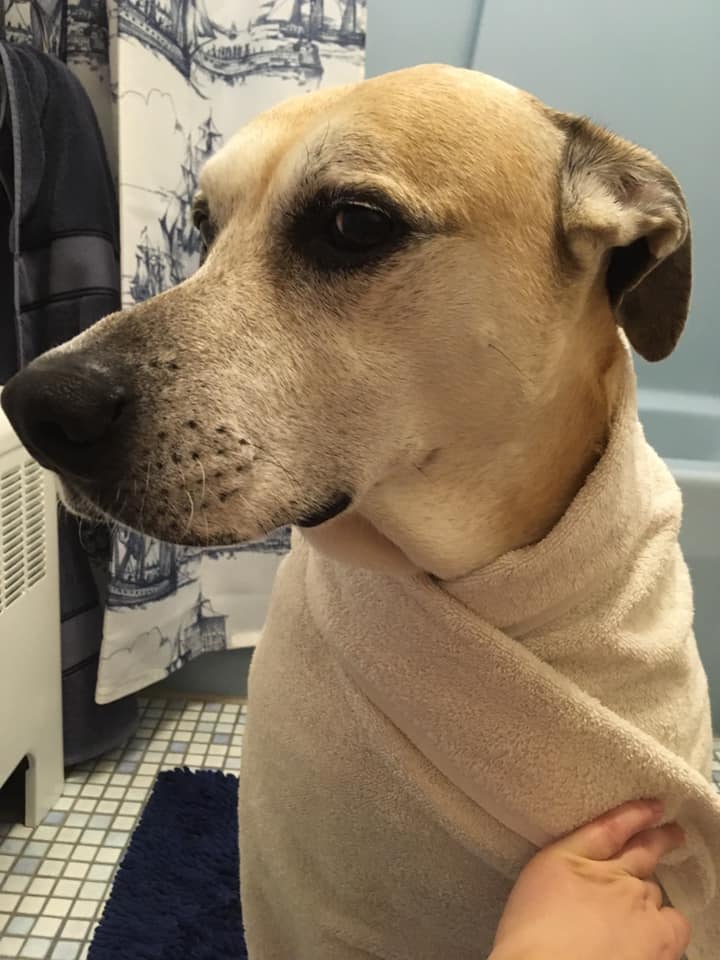
We don’t have pet insurance but I do have a $1,000 dog health sinking fund so we have some money set aside for any emergency vet care. We mostly bring her on vacation with us – we camp in pet-friendly cabins. Otherwise, my mom stops in to take care of her if it’s just an overnight.”
Allison wrote, “This is Lola, our miniature dachshund. We searched for a vet that would care for her and charge less than the $300 we had been paying for her yearly check-up and shots. Now we drive farther into the city to a no-frills vet and her last visit with shots was $80. It also helps to have a tiny dog (she’s 7lbs) that doesn’t eat much and has short hair. We do any grooming at home and spend about $16 every couple months for her bag of food. (Lola says, Go Chiefs!!!).”
Jennifer shared, “I have been in the veterinary industry for 25 years. I commend pet owners who are wisely frugal. Where not to be frugal? Routine wellness and acute medical care, parasiticides, preventives and dog food. We have had patients who’s owners have decided to make their own food, but.. it is not as easy as dismantling a rotisserie chicken. It requires a gram scale and measuring raw supplements and minerals. But, if a pet owner is willing and able, more power to you!
If you are looking for a reputable OTC dog food, with excellent quality control, Purina Pro Plan is great. Most reputable veterinarians do follow the AAHA, AAFP and AVMA vaccine administration guidelines. This includes a 3 year vaccine rotation of a distemper combo for both cats and dogs, after the initial puppy/kitten series and the first adult booster on or about 14-18 months of age. Do your best to cut costs, where it won’t negatively affect your pets health and well being. Always remember- be an educated and aware pet owner, but never confuse a Google search with a Veterinarians medical degree. Keep loving your fur babies!”
Karen shared, “I go to low cost vaccine clinics for routine shots. At the very least it saves me the $50 cost of an office visit which is always in addition to the vaccines. I follow a particular mobile vet but there is always a clinic going on somewhere in my area.”

Em wrote, “We have 3 dogs, (L to R in the photo) Sawyer, Scout, and Bali. We believe that investment up front with them saves $$ in the long run, so they’re fed a relatively expensive, highly rated grain free food. We are fortunate to live in a larger city with multiple vet offices, so we called around and interviewed them regarding prices and policies before picking the best one that offered the widest range of hours, cheapest pricing, best flexibility as far as “required” services, and great customer service. We do grooming, bathing and nail trims ourselves.
We take them walking and hiking often to keep them healthy and active. Fortunately both of our families are big dog lovers, so if we travel and are unable to take them, they get babysat like grandkids 😂. As far as toys go, the only things we buy are antlers. They’re more expensive up front, but they’ll last 1-3 months each, whereas other toys last between 5-45 minutes 😂. While it may seem like having dogs isn’t the most frugal choice… they’re far cheaper than the therapist I would need otherwise!”
Terri wrote, “This darling spoiled 17 1/2 year old girl… found underneath the hood of my car when she was barely a month old… simply gets whatever she wants. I do use coupons/ etc where I can, but she has gotten much more finicky in her old age. Food… this is a mix of whatever she will eat based on age and finickiness. Right now she eats a lot of roast pork, chicken, turkey, canned cat food and cat treats. The vet says whatever she will eat. She has always been an itty bitty cat.
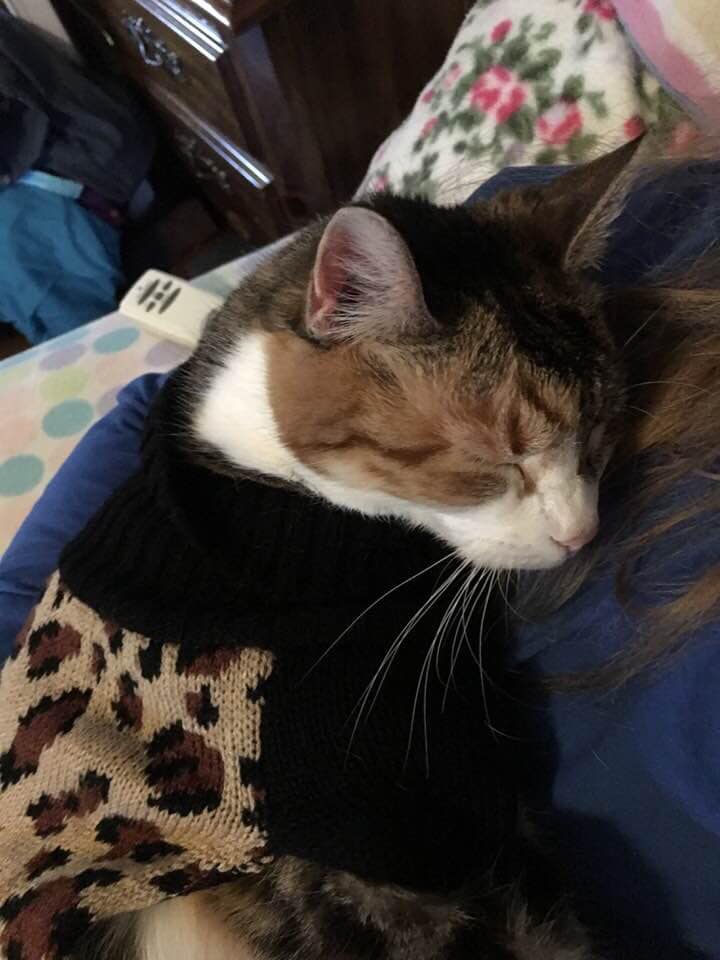
Her little sweater was bought at a thrift shop. She has several cat trees in the house… all gifted to her. She had a pet bed next to nearly all radiators in the house… some gifted, and some purchased inexpensively. Toys… she is a typical cat… a box and a piece of yarn entertain her for hours. I buy handmade cat nip bags at a local farmers market for 50 cents. Vet care.. . She gets her annual care. Now in her old age she is having some obvious issues. I draw a line at how much crazy testing we will do on an old cat. As I tell my vet… you should be able to take your best guess based on physical exam and blood work and treat from there. There will be no ultrasounds, MRIs… My goal is for her to be happy and comfortable. So we do go to the vets if she seems uncomfortable or different.
Last cat I had suffered from kidney failure. I learned to do the subcutaneous fluid injections at home myself. The vet wanted to charge me $30 a bag for saline. I’m a nurse, so I talked to my pharmacist and found they paid less than $2 a bag for saline. I found an online vet medical supplier at $8 a bag. I told my vet I realized they needed to stay in business, but I was unwilling to pay a markup from $2 to $30, and that if he would write me a prescription, I could get the fluid for $8 a bag… he ended up selling me the bags for $8. At any rate, my cat is truly my one priceless treasure.”
Betsi wrote, “Our farm and ranch store does pet vaccine clinics every month for cats and dogs. It cost a fraction of what it cost to take them to the vets. The do a wellness check plus their vaccines!”
Jennifer shared, “My fur babies do the wellness plan with Banfield in petsmart. It has really helped keep everything consistent through lots of military moves. We have been really lucky to have loved the vets that they have on staff.”
Pet Insurance: Yay or Nay?
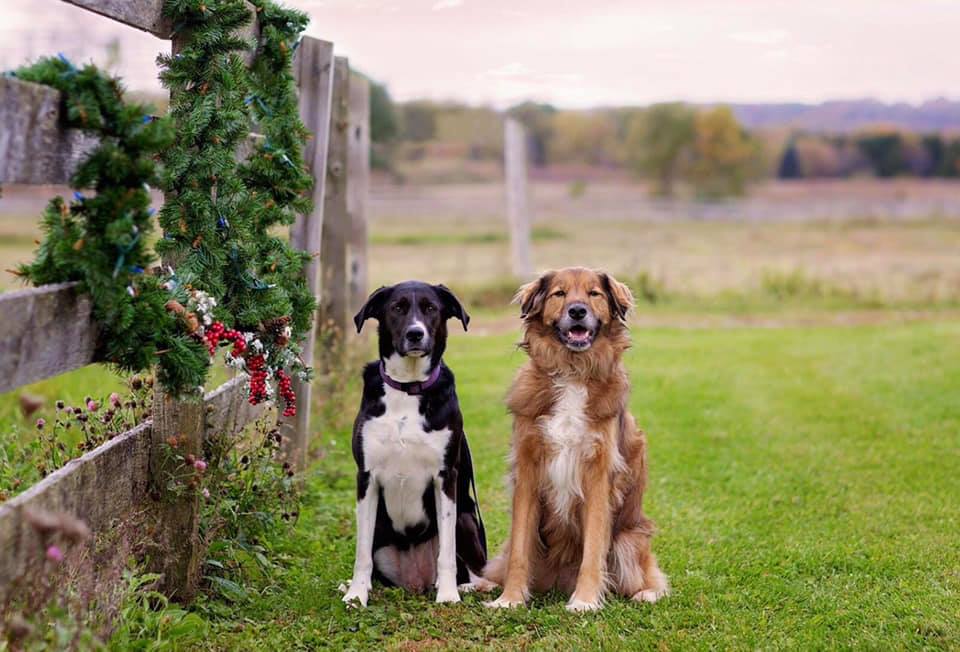
Donna wrote, “I have 3 dogs. We don’t have a ton of toys. They destroy them quickly anyway. The ones we do have a rubber tough ones or stuffing free ones and we usually get them online (chewy, petedge, etc). Learn to cut nails, brush teeth, etc. Will save $$ on grooming.
Petsmart will price match any of their own online prices and their online prices are almost always cheaper (but chewy, Amazon,etc. are usually still cheaper). Pet supplies plus is where I usually shop if going to a store.. they price match from anywhere including online and are cheaper than the petsmart, Petco, etc. I don’t skimp on food. Good quality food keeps them healthier overall. I feed canidae and merrick, but every dog is different and some tolerate things differently. Definitely meal feed and keep weight healthy… another way to lower vet costs.

The one thing that I wholeheartedly advocate for is a good insurance. Get it as soon as possible because pre-existing conditions are excluded and of course it’s cheaper the younger your dog is. I have family and friends who don’t agree, but even if you put that $$ in a savings account, it only takes 1 thing to wipe you out and I never want to be in the position to make a decision about the life of my dog because of $$. I also just proved how worth it it is. My youngest was just diagnosed with Addison’s 4 weeks ago. Suddenly everything I ever spent for his insurance I got back in a single weekend of care because of how sick he was. And all his future needs (meds and blood work) will be covered at 80%. Even if I had never used it… still there’s a huge benefit to peace of mind.”
Jayne said, “No pet insurance, we did the math, it doesn’t pay. We have a Care Credit credit card for vet & for human dental — no interest if charges are over $300 and paid off within 12 months. A better deal than insurance that we might not use. Showers at home. Nails & ears at home. Costco Store brand dry dog food, topped with veggie scraps from kitchen food prep (we are vegan). Co-op dog sitting with a friend (we have 4 littles & a tortoise, she has 2 bigs), no money ever exchanges hands. Low-cost vaccination clinic. Vet visits only when necessary. Toys on sale or clearance.”

Tamara shared, “Our dog Benton has anxiety and health issues. Since we know there a several costs for him, we chose to enroll in a pet care program at our local vet. We pay a relatively small monthly fee ($39) which covers his well checks, vaccines, annual teeth cleaning, etc. We also get discounts on various other services as well. We love Benton and want to keep him healthy and happy! ❤️🐶”
XMAS TREE Kelley wrote, “Both our dog and cat we came to for free. Dog was a puppy mix, which meant we needed all the vaccinations required for a new pup. We used Banfield’s 12mo insurance policy to cover his vaccinations, neutering, and vet visits, much cheaper than paying outright for each. Since then we payed for another 12mo policy for a specific medical issue and a rabies vac because we felt like there was a cost advantage. Our cat we got from a SPCA which had a free adoption weekend. Already spayed and had the majority of her vaccinations. Neither get groomed, we bath them ourselves. No food hacks outside of portion control (they get plenty of table scraps from our 2yr old). They board with family members if we’re ever gone for extended durations.”
Grooming and Claw Trimming

Jennifer said, “I just recently started grooming our dogs myself. I realized that buying the good quality clippers and tools that I needed would cost about the same as two groomings. So I did that, and then also spent $42 for one month of grooming videos and watched as many as I possibly could (invaluable!). Now I feel comfortable doing the whole grooming process, and I get better with the clippers and shears each time I try. It’s a pretty big cost savings considering that where we live, it’s $150 every time we get our two dogs groomed. That said, I also now have a healthy respect for how groomers earn their money! We do not have pet insurance, but keep funds allocated in our savings for vet visits and emergencies (I think this only works best if you start building those savings when they’re young). For boarding, we found a sitter we love from Rover. Here’s a pic of Digby and Annie.”

Jen wrote, “I definitely do our own grooming with the $25 dog clippers I bought several years ago. For food she honestly gets the regular dry food that’s not the cheapest, but not the most expensive. I often top it with some cooked veggies, yogurt, salmon/chicken skin, etc.
Her treats are usually homemade (super easy – and dogs don’t care what they look like!), a slice of cheese from the fridge, or a bag of something I picked up at a discount store like Marshalls. For vacations we usually have a friend watch her. Mostly we can manage an exchange with friends: we have watched their dog, so they also watch ours. If it’s just a two-day thing then our neighbor, whom we have a great relationship with, will willingly pop over while we’re gone. For the vet, I honestly don’t worry about price. I can usually finding free rabies clinics when it’s time for that. But otherwise, the vet I found has taken care of her with such great concern (she has some special issues), that I don’t care what it costs.”
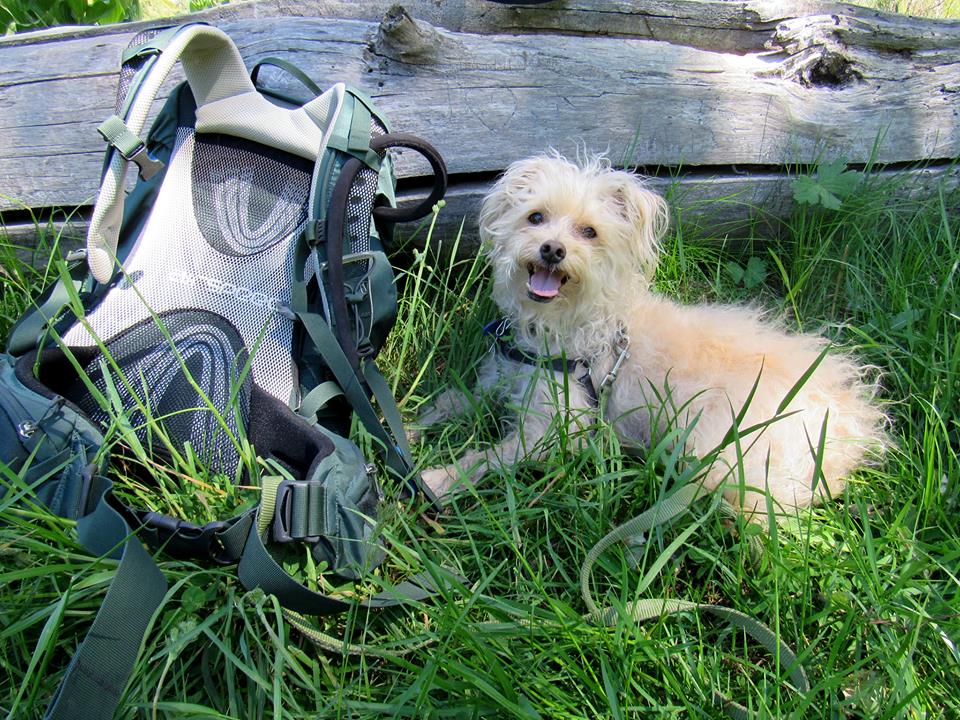
Siera shared, “Jepson is my little scruffy buddy and goes almost everywhere with me! I adopted him from our local shelter almost 6 years ago, and the $90 adoption fee included neutering and his first shots. He gets good quality food, regular vaccinations at a local clinic, and plenty of exercise on walks.
He’s pretty low-maintenance and I do all of his grooming myself – brushing, bathing, nail clipping and teeth brushing (which he hates, so more often he gets dental sticks/chews to “clean” his teeth). He’s an indoor doggy and sleeps at my feet on the bed wrapped in his own blanket. He gets cold easily, so I’ve made him some jackets out of old sweatshirts and scrap material (I did buy one “puffy coat” for him on sale!) He’s a great traveling dog and a good hiking buddy, despite his small size! When we travel without him, he stays with my parents, who also adore him 🙂 He is more than worth every penny spent on him!!”
Melissa shared, “We buy toys on sale if we can and not often. One of the cheaper but still good pet food. She has vet visits once a year for a check up. No pet insurance. If we go away friends/family take care of her for us. We also have a friend who is kind enough to trim her nails for free!”
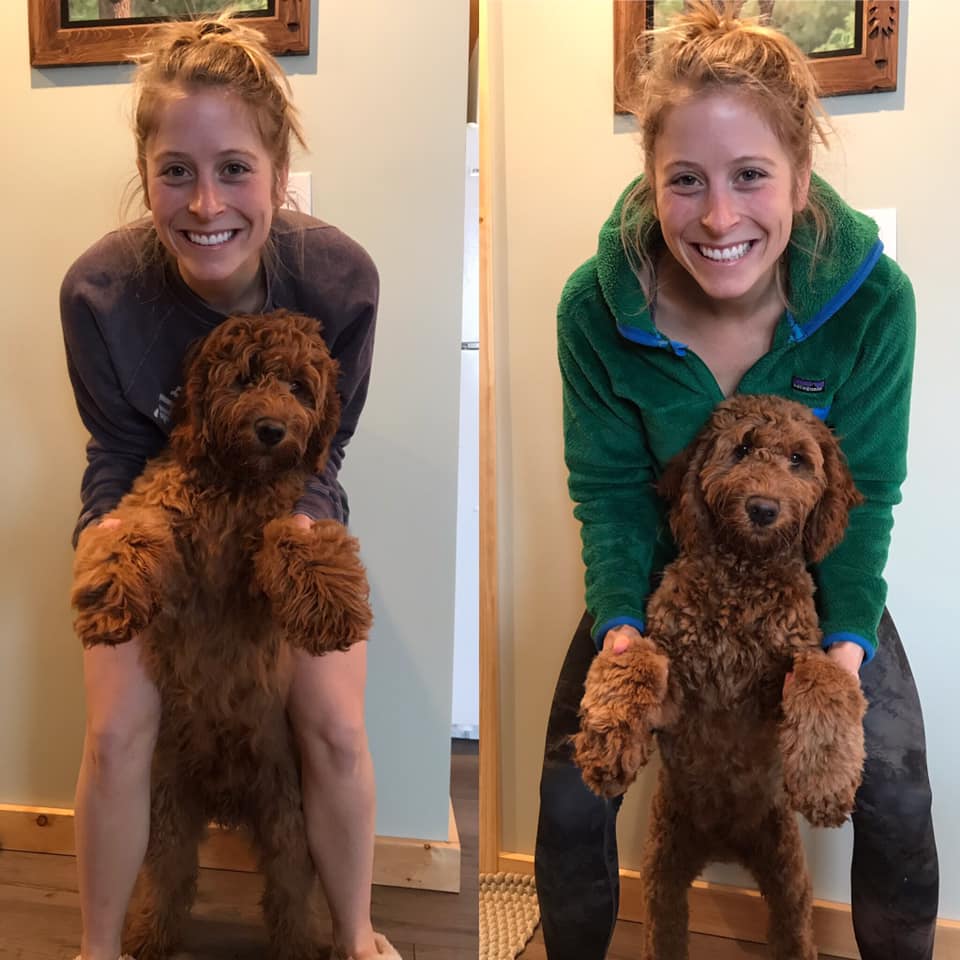
Katie shared, “I love this question and actually most of what we do comes from you! Before I read Frugalwoods, we did the most expensive dog food and our pup was groomed every 3-ish months at $80/time 😳 now we do the grooming ourselves along with Sam’s Club brand dog food which turns out to have the exact same ingredients 😏 We got a second dog recently so now have two dogs and our budget still comes out less than when we had one and weren’t DIY-ing the grooming. Our next endeavor is to learn more about dog training as ours have had some issues with resource guarding and a lot of what we read says to get professional help. So we’re researching and trying some tactics ourselves first and then will get a trainer if that doesn’t work. The photo is a before and after of our puppy’s first time getting groomed (saving us $80!).”
Allison wrote, “I bought clippers for around $100 to clip my cocker spaniel. At Petsmart it routinely cost $75 plus tip. It took me a while to learn and probably wasn’t as fast, but I could clip her more often than I would take her to be groomed.”
Adopting Your Pet
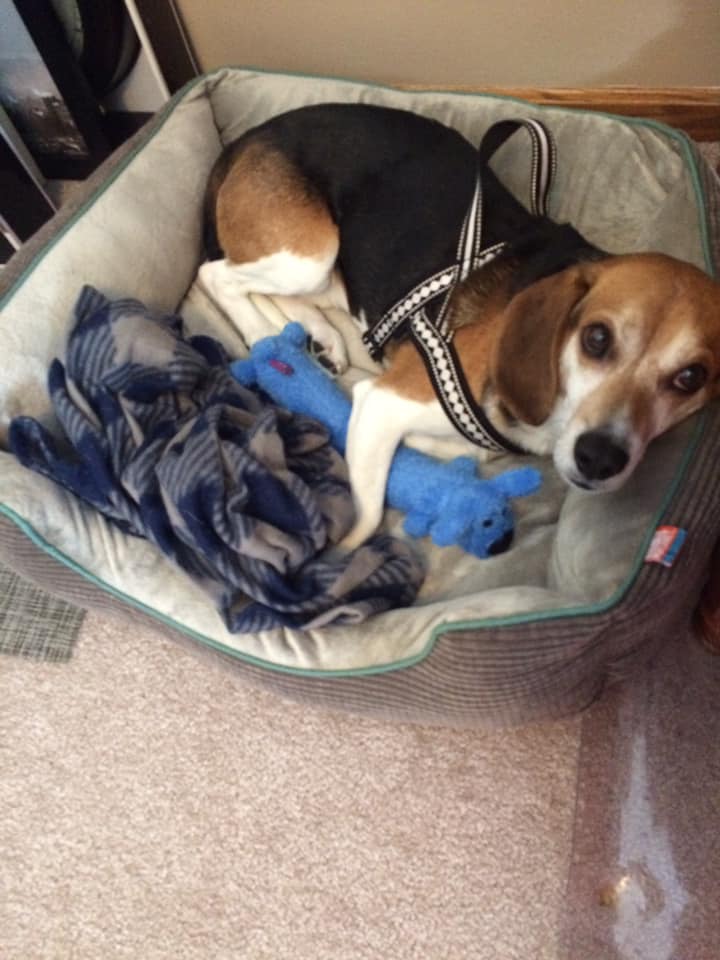
Donna wrote, “Adopting vs breeder is the way to go unless you have a reason to need a purebred dog. Adoption fees are less expensive than breeder fees and it will include their shots up to that point and often their spay/neuter.”
Shaunna wrote, “This is Roscoe! The only frugal thing about him is that I adopted him from my local animal shelter for $99 which included all shots, vet visit, microchipping, and would’ve also included neutering, except he has a bad heart and cannot have anesthesia. All of that for $99 is a great value, if you were to put a price on a family member. I knew he’d have health problems when I adopted him and he sees a vet cardiologist yearly, takes daily heart medication, and is also on prescription food. While none of that is remotely frugal, it’s an area I do not scrimp on so he can feel his best and keep his health from worsening. I do trade pet sitting with my parents and sister which does save on pet babysitting. He also only likes one specific toy which I sew a few times before I give in and buy him a new one.”
Beth advises, “ADOPT don’t SHOP! Research your breeds before deciding on any dog. Pick a dog that matches your lifestyle. Long furred dogs will need brushing and grooming. High energy dogs will need plenty of exercise or daycare. Many purebred dogs have health problems due to inbreeding (German shepherds prone to hip displasia, golden retrievers prone to cancer, snub-nosed dogs prone to heat exhaustion, small dogs prone to dental nightmares). All dogs need a home, but be sure you’re not supporting irresponsible breeding that leads to dogs having unhappy/unhealthy lives! AND that you have the $$ if regular vet visits are expected.

We adopted our pup from a Humane Society for FREE fully vaccinated, microchipped, neutered, and treated for ringworm (he was a stray). In his first four years of life we’ve only needed one trip to the vet when he ate a bunch of string (??) other than regular check ups. He’s got short fur so I bathe and trim his nails at home. We have Petco repeat delivery set up for his food. We pay $35 yearly to support our local dog parks, which we go to weekly and are beautiful places to hike! I run with him every morning to ensure he’s tired and won’t destroy the apartment while we’re out. Instead of expensive dog treats we use hot dogs or leftovers, which he is thrilled about. Last year we spent $687 on food/vet bills/licensing/etc. – worth every penny!”
Lisa’s dog was, “Adopted from a kill free shelter. 10 dollars included spay and chip.”
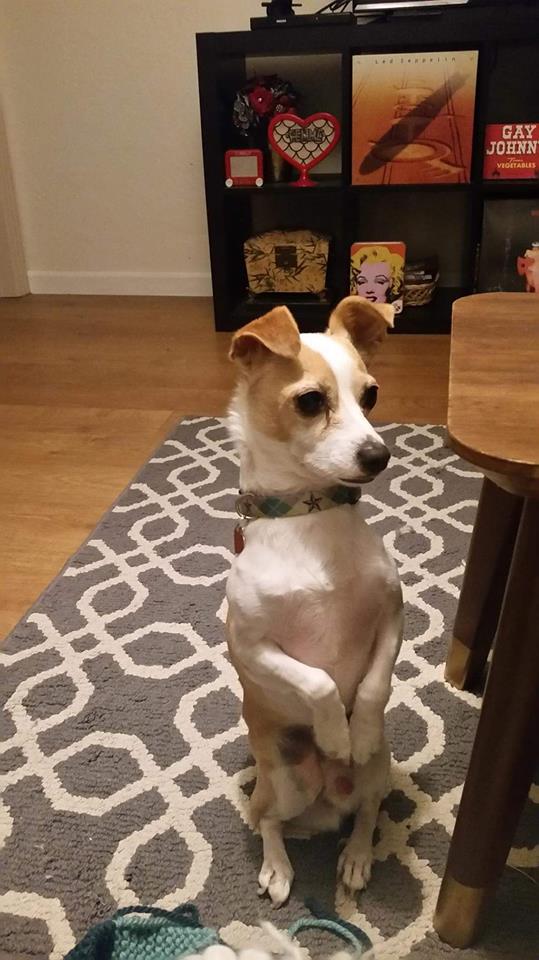
Allison wrote, “After my beloved Australian Shepherd rescue died, we decided our next dog would be a dog small enough for us to easily carry, as trying to carry an aging 50-60 lb dog and get her in and out of a car wasn’t easy for her or us.
Bonus: It had not even occurred to me that a smaller dog EATS LESS FOOD!! So, dog selection is key. Our guy likes food puzzles. He’s wicked smart. Those things are expensive! We buy some new, occasionally swap with friends, and also make up our own. We use old holey socks and tie up food in them, hide them for him to find. We’ve also made DIY puzzle boxes by stuffing treats into cardboard tubes, other small boxes, etc, and then letting him have at it. So good for his little hunter brain! Jack Russel mixes need the stimulation!”
Aurelia wrote, “In 2016 we were adopted by a 6 year old greyhound/shepherd/lab mix. First of all we saved money by adopting from a rescue rather than buying a dog from a breeder. We found a reputable rescue that matched us with the perfect dog for our needs and they even delivered her from Florida to Rhode Island ( we ❤️ No Paw Left Behind rescue). We also saved money by adopting an adult dog (no peepee pads, no training fees, she is perfectly independent and ready to spend the day on the couch while we are at work therefore we don’t need a walker). She came to us with allergies and we worked through multiple diets until, with support from our vet, we decided to cook her food in house and give her vitamins to make sure she isn’t lacking anything in her diet.
For grooming, I do everything myself: baths, clip her nails ( we tried the drill but she was terrified of it), I clean her teeth with a scraper and brush them in order to avoid having to put her under anesthesia as it’s dangerous for older dogs. For toys she has her balls and elk bones to chew on. She doesn’t get treats (allergy reason). In order to keep her stimulated we try to walk her 3-4 miles a day for 1-2 hours and take her to the beach as often as possible. I guess we saved on the dog bed too cause she sleeps in bed with us, perched all the way up on our pillows. We love her to pieces and she is very much worth the $800-$1000 we spend every year. From my point of view she is saving us a lot more than what we spend on her by being my partner in crime and keeping me healthy both mentally and physically. Nina spent a year in Miami Dade shelter and she was in line for euthanasia 3 times. From having to go through that she came out with a will to live and a “joie de vivre” that she is truly an inspiration for us and a reminder to be grateful for everything we have.”
Food and Treats
Erin shared, “Dogs love carrots 🥕. A bag makes for frugal and healthy snacks!”

Jennifer wrote, “I have two cats, Penny and Nora, who are spoiled. When I travel, my roommate watches them. If she’s not available, I have a friend who lives nearby that will stop in to care for them. I usually get her a gift card to the grocery store to say thank you but it’s much cheaper than the $30/day for other pet sitting services. I price compared so I order their canned food on chewy.com. I get litter and grain free dry food at Costco. Nora has digestive issues so I’ve had to pay for more expensive hypoallergenic dry food for her but I figure it saves me money in the long run because without it she was needing emergency trips to the vet every few months and those add up quick! I don’t have pet insurance but I found a local vet who is wonderful and reasonably priced.”
Karen said, “We have always bought top quality dog/cat food. No ‘treats’ in their lives, except toys. Once a year visit for shots, have friends/family care for them when we are away, and do all bathing, etc ourselves. I do splurge every few months for nail clipping on dog. The cats lived a healthy 21 years, 22 years, one lab 14 years, and now second lab is 15 1/2. I have a theory that a lot of dogs are overfed, which leads to a lot of health problems. Nobody can believe my current lab is 15, she has no health issues and looks like she’s about 6 or 7.”

Caroline wrote, “We realised the supermarket-brand dog food we were buying for our dogs was sub-optimal, but couldn’t afford the premium stuff by any remote stretch, and where we are (in South Africa), there just isn’t the competitive range, SO we researched smaller, less-well-known brands sold by local small business owners (all meeting the required standards obviously, licensed and so on) and found one that is virtually indistinguishable in terms of nutritive value from the ”one the vets recommend” but much, much less costly.
It took a bit of trial and error, but we have found that this, supplemented a few times a week with a tablespoon-per-dog of (meat-based, not garden!) bone meal keeps our dogs fit and healthy. I definitely would recommend getting pet insurance AS SOON as you get a pet, while they’re still young. We didn’t with our two older dogs and now the cost is prohibitive.
We have done with our cat (got her at under-1) and much of the foreseeable vet expense is at least mostly offset. Will do this in future for any new pets.”

Katie wrote, “The vet said my dog needed to lose some weight and suggested trading some of her dry food for wet food. Since she’s little, I couldn’t buy the larger, more economical cans of dog food and had to constantly buy the little cans.
Between the time and money I constantly spent on small cans of dog food, I figured it’d be cheaper, faster, and healthier to make her wet food myself. I boil chicken and veggies, which she loves, and store it in small containers in my freezer. Since I make her food, I never worry about food recalls or needing to read reviews or labels to ensure she’s eating healthy food. And I get to keep the chicken broth for soups! My neighbor volunteers at a local animal shelter and suggested I visit their weekend clinic to update my dog’s vaccinations, which cost about 1/3 of what my vet charges. She saved me a fortune!”

Hope shared, “This is our fluffy princess Hilda. Here are things we do to keep costs reasonable while still making sure she has the best life possible:
1) find a good vet that you trust. Our last cat was very elderly (lived to 21!) and we found a vet that we loved and trusted who always talked through different treatment options and was upfront about costs. If she recommended something we knew it was important.
2) we adopted Hilda, so $0 for adoption fees, and she was already fixed. All we had to pay for was annual vaccines.
3) we do feed her wet food, as it seems that’s an important factor for cats, but I compared ingredients and discovered that the ultra cheap store brand has the same ingredients and nutrition profile as the expense brand names, so she gets HEB’s finest cat dinners.”

Martha said, “This handsome cat has prescription food for kidney stones. I trim his claws, and he sees his vet every year. I buy special litter that colors if he has a urine problem beginning so I can catch it early and take him to vet. He is not a frugal cat, but I love him so much. Anything for his health.”
Kristen shared, “I have 3 pups. I feed them a high-quality food as that’s their primary source of nutrients (you know, other than poop and stuff). 🙂 I also have them vaccinated at the vet. I don’t buy dog treats. What they get are carrot pieces and they absolutely love them! They’re also huge fans of peanut butter and almond butter, so they get Kongs every so often. I used to save when we traveled by swapping dogs. A friend has 3 as well so she’d watch mine or I’d watch hers. It worked out wonderfully until she moved away. Much sadness. I have yet to find this trade system again. I do have someone who adores my big ole guy, so he’s always set, but their fence isn’t ok for the littles. I often take one little with me and the other goes to whomever we can find to watch him. I do also have a woman who stays in my home for $30/day to watch all 3 which is way cheaper than most other options. All 3 of my hounds were rescues. They’re the best kind!”
Emily wrote, “My best tip is to stop buying those either horrible quality or over-priced treats and make some yourself. My go to is a $5 chicken (raw or rotisserie). I pick off meat for 1-2 meals for us, boil the carcass for 5-6 hours, pick out the bones, save the broth for meal time, and the tons of extra meat that falls off the bones for treats. Just put it in a Tupperware in the fridge. I usually lasts a whole week for my 5 dogs. And I take the broth and either we eat it or I mix it in with their dry dog food. It goes sooooo far. Can’t beat it for $5.”
Pet Boarding, Babysitting, and Travel
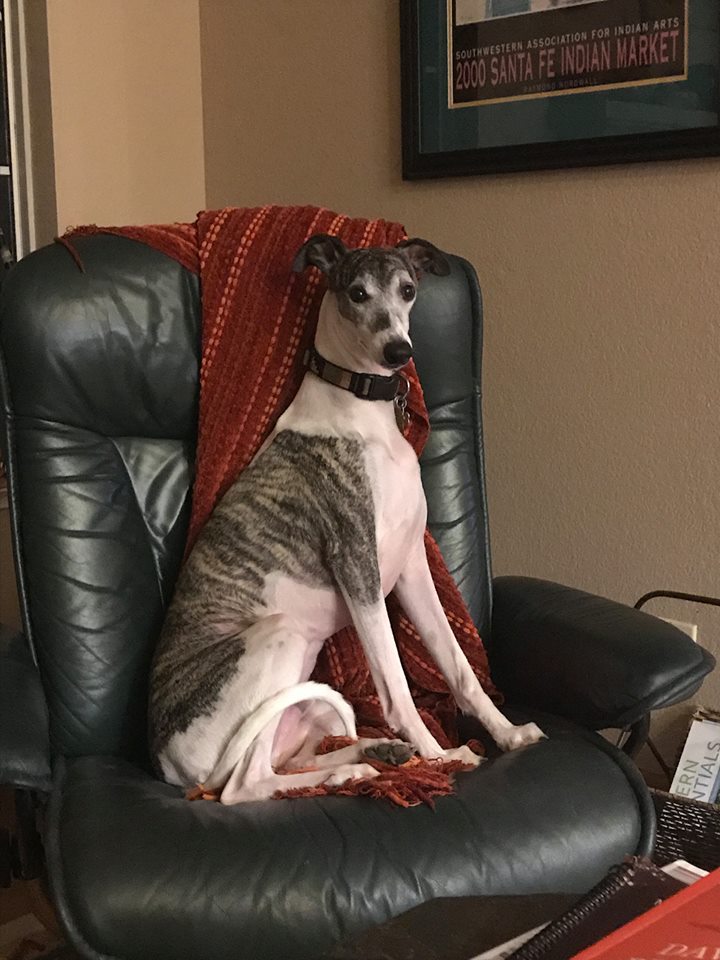
Jan introduced us to, “Robbie the whippet! A sweet boy! Whippets tend to be low maintenance and total couch potatoes. Regular baths in the tub and trimming nails with a Dremel. Food is from Costco, Kirkland lamb and rice, treats and jerky. Annual visits to the vet. Robbie is my fifth whippet. My previous whippets required more care as they aged and Robbie will as well.
For me, the key is once you make a commitment, they rely on you to be there for them and provide them with good care. They provide such unconditional love and rely on us to do the same, even when it is time to say goodbye. When I travel, I have a trusted friend who cares for Robbie in my home.”
Stefanie shared, “I have 2 friends that I have an arrangement with. When I am out of town, they come to my home and care for my furry buddies and vice versa. So we barter pet care.
It is indeed possible to price check vets to be sure you get the best deal on services, so we did. When I adopted our neighborhood stray cat, now named Shady, 10 years ago, I took her to the Humane Society’s low cost spay/ neuter/vaccination clinic where she was also tested for FIV. It cost about $80 compared to the $250 it would have cost at my vet for all of those services.
We don’t have pet insurance. Over the last 11 years, we have only had 3 unscheduled vet trips which cost a total of $350…all for Puff. Puff came from the Humane Society where he had vaccines, microchip, and neuter services, all for the low price of $60. I don’t buy toys, they have fun with free stuff.”

Lieu introduced us to, “My spaniels. I groom them every six weeks. The spaniel on the left has food allergy so we feed them Holistic Select Adult Health Duck Meal which is not cheap but they are happy and healthy. We take them with us when we go on vacation to save money on kenneling.
We do have pet insurance in case of surgery. We try to be frugal with them as much as we can. They are our world and we love them very much.”
Emma wrote, “These are our three. 14 years, 3 years, and 2 years. It is a lot, but they found us.

We buy locally made dog food which is very high quality and much cheaper because it is local (Fromm’s adult gold, about $45/33lb and every 12th bag is free). Because it is high quality, they do not need as much and hopefully will have longer and healthier lives. For toys, we only have 3. An XL kong, a large chuck-it ball, and a Nyla bone.
These are the only long-lasting toys we have had success with and we have only had to buy one of each so far. The bone prevents dental issues as well. We do most of the recommended preventative care, especially because they spend a lot of time in the water and woods. When we go away, we have family dog-sit or a friend (which is much cheaper than boarding them and they aren’t potentially exposed to diseases in a kennel). Not that other ways of raising pets are wrong, but this is what we’ve found works for us 🙂.”
Summary Ideas

Thank you to everyone (human and otherwise) who contributed their advice this month! NOT TO MENTION THE PHOTOS!!!!
The overarching theme threading through all of these comments is that caring for a pet frugally doesn’t mean neglecting an animal’s health or wellbeing.
There are ways to save money in nearly every aspect of life and that maxim holds true with our pets. You do need to bring focus and diligence to how you parent your pet and what you buy for them, but it is entirely possible to spend less and still have a thriving pet.
Here are the suggestions many readers highlighted and that I think provide an excellent overview of responsible, frugal pet care:
- Research breeds and types of pets before bringing a pet into your home. Determine what type of pet/breed will best fit in with your family, your lifestyle, your travel and work schedules, the size of your home and yard, whether or not you have children, your physical capabilities, and more.
- Adopt, don’t shop! When you’ve determined what type of pet will integrate best with your family, please consider adopting from the Humane Society, an animal shelter, or an animal rescue program.
- Find a reputable vet and don’t be afraid to shop prices around. Call vet offices to determine their prices for routine appointments as well as their familiarity with your pet’s breed/type/medical conditions.
-
Babysitting our friend’s greyhounds = wild & crazy greyhound party! Research the type of food your pet needs (with your vet’s guidance) and then work to find the least expensive option that’ll still provide the nutrients your pet requires. Frugal Hound did best with a grain-free diet and specifically with the Taste of The Wild Salmon and Sweet Potato kibble. We initially paid for this premium food until a wise Frugalwoods reader alerted us to the fact that Costco’s generic Nature’s Domain kibble contains (or, at least, it did at that time) the exact same ingredients as Taste Of The Wild. For a fraction of the price!
- DIY everything you can. Grooming, claw trimming, bathing, teeth brushing… all of this will pay dividends over time. Since these are repeated expenses, doing them yourself will save you money every single month for the duration of your pet’s lifetime. If you’re unsure about your grooming abilities, take to the internet and do research specific to your pet/breed.
- Create a pet swapping arrangement. If you ever travel without your pet, get together with friends who have pets (or who love pets) and coordinate a pet swapping system. When you go out of town, they watch your pet. When they go out of town, you watch their pet. This is what we did with Frugal Hound and we never once paid to board her, despite our rather robust travel schedule. We were the happy hosts of dogs of all sizes and types, which made for some hilarious and adorable memories. No money ever changes hands and the humans and animals are all happier for it.
Caring for a pet frugally entails creativity, resourcefulness, research, and compassion. It doesn’t involve skimping on veterinary care or required medications. The goal of raising a pet frugally isn’t to save as much money as possible. The goal is to be considerate of your pet’s specific needs while avoiding unnecessary expenses.








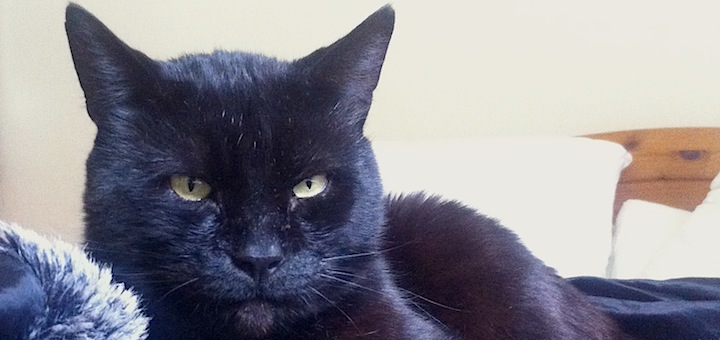
I’m sorry I can’t post a picture of my dog. LOL. His name is Freddie, I got him from the SPCA. He was already neutered. Our vets office will trim his nails for free as long as we’re there for something else, so I figured why not just let them do it. I also don’t want to be bitten! I do cut his hair myself though. He does not like it at all. LOL. He is a little guy. He weighs about 13 lb right now which is a healthy weight for him. When I got him he weighed about 5 lb, he was extremely underweight. The SPCA had said he was a stray. He didn’t even have a name, just dog 150. I call it his inmate number. LOL. I gave him the name Freddie. We have been together coming up on 5 years. He is my baby and I love him dearly!
Some of his medicines I get from the vet, others I ask for a prescription and get it filled at the pharmacy. Right now he is on Claritin and I was able to find that for $9 and some change for 365 pills on Amazon. He only gets one a day, so that should last him about a year. He has allergies and his eyes itch. The previous (prescription) medicine he was on was not helping, so the vet suggested I try Claritin. We have been with this vet for close to twenty years. Ask for a pet bed, he sleeps with me. He is very hard to buy toys for! most of them he destroys fairly quickly despite being such a little guy. He cannot have the soft rubber ones because he chews them into pieces and will attempt to eat the pieces. He cannot have the rope toys because he picks the strands apart and I’m afraid he will ingest them. I occasionally find a stuffed toy that works for him (but he usually eventually still chews these open and pulls out the stuffing, however I can usually put everything back together and sew it up). He likes the squeakers, but usually has them broken within the first 10 minutes. I have had a lot of luck giving him the hard rubber toys like Kong or a knock off of that, but those don’t squeak.
Love this post and seeing all the photos of furry friends! I miss Frugal Hound, too.
We feed our pup Nature’s Domain beef and sweet potato from Costco. My dog hates, hates, hates getting her nails trimmed. I used to take her to the pet store for $10, but recently they haven’t been able to do all of her nails! I’ve found that if she gets walked a ton, there hasn’t been a need for a trim. The vet will do it when we go for checkups.
I bathe her myself, but every now and then, we will go to the pet store when I have a coupon for a bath. They’ll do her ears and anal gland expressing (yuck) too.
I have a friend who will stay at our house and watch her for free when we go on trips. I used to swap with a coworker who had a dog, but they moved away.
We don’t skimp on vet care. She gets all of her vaccines on time, including Lyme since we hike in the woods. She gets a monthly heartworm preventative. Costco also sells Frontline.
I have 2 labradors. One I adopted and one I got for free. I work at a vet school so I get a 20% discount on all services and meds. Their annual exam, all shots, a 12 month supply of Bravecto and Interceptor Plus Heartworm is $300 per dog. I exchange free pet sitting with my neighbor. I occasionally but them a stuffed toy from Goodwill for $1. They find tennis balls for free :). No need for daycare as they have each other. I feed them a high quality diet of a reasonably priced grain free diet – Taste of the Wild, and the only treats they get are generic milk bones from Menards ($6 when they go on sale for a 10lb box). I spend about $120 a month total for both of them (that doesnt include non-routine vet care – so far we’ve had no issues). Because of them I want to be home or hiking with them so they save me money in the long run.
Good informative post. I would also agree about adoption. All our cat have been from adoptions. The last cat and current cat where both “older” cat adoption from the local humane society, I believe $30 and came with all shots, chipped, and a free vet visit.
I’d encourage anyone on a grain-free diet to look at new research linking this diet to cardiac issues in dogs!
I was going to comment the exact same thing. As a veterinarian who works part time filling in at an ER as well I have has SIX cases of dilated cardiomyopathy related to grain free/boutique foods within the last 2 months alone. Some of these were young dogs in end stage heart failure. Absolutely heartbreaking. http://vetnutrition.tufts.edu/2018/11/dcm-update/
Excellent post. With 13 cats, I thought i knew all the tips to frugality with pets, but I just learned more. I have had 2 cats need at home fluids and never thought to get them from a regular pharmacy. I do get their thyroid meds and a heart medicine from the Walmart pharmacy to save money, but never thought of fluids. Thank you.
I have a miniature treeing walker coonhound, aka as a mutt, from the local animal shelter. She was not cheap, but every penny was worth it! I know it cost way more than I paid, for the shelter to save her life. And now I am saving her life, everyday, with lots of love and spoils. One thing we like to do that’s frugal is walk to the local pet store and by whatever dog or cat food is 50-75% because it’s close to its sell-by date. It’s usually brands that I would by anyways. I will not compromise on good quality food, but if I can get it cheaper, that’s very helpful. Also we have a local low-cost vet clinic in our area that I take the cats to, when they just need their shots, and save the vet for more serious issues. My vet can be expensive, but they always do a thorough job. I just like to use them, only when I need it most. I also like to buy my dog bones from the local butcher at the farmer’s market. They are $5 a piece and they are the biggest smoked bones I have ever seen. I could probably go on about pet frugality, but I will just leave it at those three things.
Another options if your pet was not Spayed/Neutered when you got them is the Spay wagon – in MA. Super affordable! Also, a tip for flea collars when you have multiple pets: We have a seresto collar and when we had multiple cats we rotated the collar every couple weeks and it worked just as well as if we had gotten separate collars but at a lot less $$
We have typically adopted pets, but a few found us (aka were secretly dumped in our yard at night or we found them abandoned, and couldn’t find their owners). When we adopted our latest pup, she had just been placed with the local Humane Society by the woman who found our pup and her litter mates abandoned in a cardboard box when still very tiny. The woman had taken care of them until they were old enough to adopt out. Our local HS gave her to us for free. She had not been spayed yet, but through the local HS, we were able to get her spayed at the HS discount price by our local vet who coordinates with them. We also paid to have her chipped. She already had her puppy shots.
We buy some treats, but not a lot — she loves carrots, apple, and meat scraps that aren’t heavily seasoned or sauced. She’ll also eat leftover veggies, but only those that are safe for her are offered. We feed her a grain-free diet from an independent pet supply store with very competitive prices and a buyer’s reward program — I get every 12th full-size bag for free. I split the bags at home and freeze half until the first half is used up, to keep it fresh. I do the same with my cat’s food — he is one of the “dumped” animals we’ve had.
We definitely keep up with vaccines and parasite medications– we live in a wooded area and many raccoons carry rabies — and mosquitoes are the state bird here in Florida (heart worms). However, we visit the low-cost clinics held every few months by our local HS, and get most of their vaccinations and some meds there without an office visit fee and with reduced vaccine costs. Our own vet is always working at these events, so that makes it even better.
We get finely ground raw chicken meat and bones or ground organ meat from one of our local organic soy-free farmers, for less per pound than the raw products at the stores. We add a dollop to their dry foods. They love it, it adds moisture and minerals to their diet, and makes it easy to give a pill or drops by just adding them to the raw meat.
I brush the pets, but they don’t require fur trimming. I trim the dog’s nails, but the cat takes care of his own on the trees. I brush the dog’s teeth, starting this when she was new to us. I pay more for doggie toothpaste, but human toothpaste isn’t safe at all for dogs. If I can prevent the tooth extractions and frequent cleanings, I’ll save money anyway.
Definitely judge, as best you can with an adopted mutt, the size, energy requirements, grooming needs, feed requirements, and chewing propensities when selecting a dog. And look to rescue organizations, private shelters and city or county shelters for your new pet. Our little county shelter is drastically upgraded, working with our local HS, and is working to become a no-kill shelter. Cats are often free to adopt once a year around here, and some dogs who are at high risk (such as old ones) for not being adopted can sometimes be adopted at a good discount.
My dog eats out of a used stainless dish. Her water dish is a stainless bowl my husband found discarded somewhere, and the cat eats out of a Goodwill-purchased Corelle bowl. Animals don’t need designer dishes, leashes, halters, or beds. Old bed pillows can make a dog bed, old sweaters and sweatshirts can make a dog jacket (one tiny terrier we used to have, had a “sweater” made out of the sleeve of my husband’s old sweater), and as many comments here say, see if you can get family or friends to watch them if you must travel without them. They’ll still cost money, but not nearly as much as it’s possible to spend, and of course, to us, they are well worth it.
Love the photos. I feed good food because good nutrition prevents a lot of problems. My vet sold me an $80 supplement for my 12 year old dog’s joints that I found online for $40 so always shop around. I follow natural vaccine protocol…rabies shots every three years followed by a rabies detox supplement I buy online. Check your state to see if they allow three year shots. She goes to the Petco clinic for rabies shots and the annual heart worm and stool test and to the vet for major healthcare problems, if any. She has only had one major healthcare incident in twelve years at a cost of $300. I no longer use health insurance as I never used it..I try to put aside an emergency fund. My vet also offers a no interest credit plan if needed.
I live in the NorthEast so now I only start heartworm in May and end it on November 1.
I used to give it year round when I lived in a warmer climate.
No longer use Frontline for fleas. I use DERMagic diatomaceous earth dusting powder when needed. It is cheaper and recognized as safe. I use Petzlife dental spray on her teeth and guns twice a day to avoid expensive dental bills. It is easier than brushing and is very effective. I have learned to be realistic about end of life care…I will limit testing and ask a lot more questions to determine if the end result is worth the stress and discomfort.
Pets are cute and lovely, but they are just so expensive to keep. Even if we can in-source most of the care, we still have to pay for registration, meds, and vet check-ins. That’s one reason why Mr. FAF and I decided not to keep pets.
I love pet fish, so we might have them one day, but dogs and cats are out of the question for now. In the future, we might revisit this when we have a bigger yard and our kids are old enough to decide if they can help take care of the pets themselves.
I vaccinate my cats myself. You can buy vials of vaccine from Dr. Foster & Smith for $30 and it has enough vaccine for 10 doses. You will need to buy syringes too but a box of 100 is about $11. Giving a cat a shot is EASY! Either do it when they are distracted (my last cat would drink water out of the sink tap and didn’t even notice the shot) or when they are relaxed (hanging out on the couch, watching Jeopardy). I even did my neighbor’s cats. New York is the only state you can’t buy the vaccine and needles (I wonder why?) but if there are any New Yorkers who want to DIY, let me know and I can mail them to you.
That’s really interesting! I had no idea this was something I could learn to do myself.
I did not know this! Thanks for sharing. How long do the vaccines last?
I love all the photos, this post made me really happy. We’re down to one dog and one cat, from 3 and 2. They’re both old and very chill now. I will say it’s easier with smaller numbers and I won’t have a full zoo again.
I have to agree with adopting from a rescue as the ultimate frugal resource! I have historically adopted all my pets over the years (1 dog, 3 cats), until this past summer when we found a stray mama cat and her 7(!) kittens in the bushes of the parking lot where I work. We decided to foster the cat and kittens in the office and they were all adopted by current or former colleagues. I have even greater respect for the work done by rescue groups. I knew it would be more expensive paying for everything for a kitten (shots, deworming, spay/neuter, microchip), but wow! I had no idea what a great deal I was getting by adopting my previous animals. My newest kitten, Cleocatra, is wonderful and I wouldn’t trade her for the world, but I haven’t even had her a year and have spent multiple hundreds of dollars on her care. (And on home items she has “accidentally” destroyed. And she’s not a very rambunctious or destructive cat!) Fortunately, she’s in excellent health and should only require routine checkups for many years to come.
A partially frugal tip: if your cat (mine is a senior) doesn’t always make it all the way into the litter box, place a dog pee pad in front of the box. Makes clean up quick and easy. I do watch to see if the frequency of “misses” is increasing as that is usually the sign she had a UTI. While you have to purchase the pads (big box usually have a decent price and I buy the large package as best per pad price), the cost is less than your time and the supplies used for cleanup.
I tried newspapers but they didn’t absorb fast enough and the urine would end up on the tile floor (soaked thru and/or “run off”).
Great post! I think too often people get a pet of whatever sort, THEN realise that the animal simply is incompatible with their lives, and then they’re shocked and upset. We (I am still ashamed of this but it did work out well in the end) decided to adopt a lab puppy when I was expecting our second child, when our eldest was around 2 and a half.
Spoiler alert. Lab puppies are adorable but also a lot of work and input. Like, a lot. They are very destructive. I was working, heavily pregnant and kept coming home to washing ripped from the line, a trashed garden (I only worked part time and someone was here most of the time during the day – the puppy was rarely alone for long). I found myself spending most of my time bellowing at the poor (lovely natured) dog, who, as he grew, kept knocking my son over and caused me to fall quite badly too.
So we rehomed him with people who lived on a lagoon, had 2 other labs and he has lived a charmed life since then. I sweat with shame when I think of how stupid, selfish and thoughtless we were to take a puppy so blithely and with no real grasp. Never again will we do that. No animal deserves to be made to feel a nuisance and a problem. Anyway, we now have 2 great dogs and a cat, and love them / care for them very well!
The moral of the story is; do your homework thoroughly and carefully. Don’t be seduced by a gorgeous ball of fluff. Babies are cute too, doesn’t mean you want one of those either!
I made a similar error when I was younger and am ashamed of how the poor dog suffered because I did not select the right breed and age for that time in my life; I am not a hitter but there was a lot of yelling and not acting very loving toward that poor guy. He, too, ended up being rehomed with a better person. I have had several dogs since then but it took a long time before I trusted myself to have matured enough to have the patience to raise a dog well. It helps that by that time I was older and not as busy with a career and school and a new love, so I had more time and also figured out that I could help the dog by arranging the environment to reduce chances for misbehavior—like buying new trash cans and putting them inside cupboards so they were not a temptation.
Our dog was diagnosed with a heart problem a year and a half ago, and she now gets a handful of medications twice a day. They are not cheap, but Costco hands down is cheaper than any other in store option, and then for the one pill we can buy online, Pet Health Pharmacy is 1/3 the cost of Costco. If you have recurring meds, shop around! It is worth it (hundreds of dollars a month for us).
To all this great advice, I’d add: research, as best you are able, your potential new dog’s behavioral issues, and be prepared to spend $$$ on behavioral support and training when you first adopt. We adopted our amazing mixed breed when she was around two, and nothing in the fostering notes indicated that although she loves people, she is extremely, extremely dog aggressive. We learned this quickly as we walked her on the city streets. If you *do* realize that your dog has a serious behavioral issue, splurge for one-on-one training sessions with a trainer who really gets your dog. As first time dog owners, we didn’t realize how outside the norm our dog’s behavior was, and multiple dog training schools put us in “reactive dog” group classes that in hindsight made her reactivity way, way worse–but at the time, we were spooked by the high cost of private training, and all these businesses kept telling us we just needed to “socialize” her and be better owners, neither of which was enough to help her. It would have been worth it, though. After we’d owned her for a few years, constantly working on helping her manage her reactivity, her leash broke on a walk and she severely injured someone else’s dog. We paid all the vet bills for the other dog–thousands of dollars–and dealt with the emotional fallout and frustration that our years of behavioral training efforts hadn’t mattered when we needed it most. Once we found a trainer who worked for us, though, she improved rapidly, even though she’ll never be the kind of dog to play at the dog park. That being said, these behavioral issues have financial consequences. We can’t do a dog-sitting swap with any current dog owners, and we prefer to pay professional walkers with behavioral training to care for her when we travel. I’m not sure how to advise here–not for a million dollars would I ever trade away the relationship I have with this weird, wonderful critter–but if behavioral problems emerge, tackle them early, assertively, and don’t pinch pennies. Additionally, if you’re adopting, budget for the possibility that your pup will need substantial behavioral support early on. Research different rescue organizations–I later learned that the organization where we adopted had a reputation among local trainers for not doing due diligence about behavioral issues. And don’t fall prey to dog-oriented businesses (or well meaning folks who don’t know your specific dog) that encourage you to do it yourself–some rescue dogs have behavioral issues that don’t respond to clickers, treats and basic training alone. Our dog has taught us patience, forgiveness of ourselves and others, better ways to react to anxiety-provoking stimuli, and a preternatural ability to find any squirrels in the vicinity. But these were expensive lessons.
I think this is really great information, especially for first-time dog owners. Even just being aware that you might not be able to swap dog-sitting services with other people–my dog isn’t great with most other dogs so this isn’t an option for us, either.
This can happen with non-rescue dogs also! Not just rescues. There are plenty of behaviorists who have purebreds with similar behavior issues.
If even these costs are too much for you at this time, consider fostering an animal! Many shelters will provide some, if not all, the supplies needed to care for the animal while they’re staying in your home. YES, this means you ultimately have to give the animal back but you helped save a life! Think of it as making lots of new friends instead of only one new friend :). I have fostered around 25 cats total over the past 4ish years. The first time bringing the cat back was very hard. The second time, a little less hard. The third time on, it became a celebration, a graduation day.
Also, if you own a pet, make sure you either have insurance or self-insure for their senior years. The costs go up just like a human, as they develop chronic conditions. There are times where your animal may need an ultrasound or testing done. To me, that is part of what you signed up for. You shouldn’t put an animal down until you know what is wrong with it and what the outcomes were. One of our cats died a month ago and her final days were quite costly. But we had a diagnosis, and we had an idea of what the different treatments were and what their likely outcomes were (not good). Since we knew that it was unlikely that medical treatment would help in her case it was time to put her down. I can rest easy knowing I made an informed decision. And we had our emergency fund to help us during this time.
I saved a lot of money by purchasing my dog from a reputable breeder knowledgeable in the health
realities of my chosen breed. Kudos to those who wish to take in a homeless dog. But I have seen
many instances where badly bred dogs end up in shelters owing their existence to the failure of
their “breeder” to even consider that breeding can be a serious occupation.
I find it wiser to make the investment at the beginning. Pet insurance is no panacea for the toll
serious illness will take on your poor pet and yourself.
Certainly not every “professional breeder” is the one with the best interests of all at heart.
Do your homework and make an informed choice.
There are also amazing rescue dogs in shelters and many shelters work on behavior assessments so most of the time you can also “do your research” there as well.
My husband works for a small animal food company (Sherwood Pet Health, if anyone is interested), who make food for rabbits, guinea pigs, and chinchillas. His boss has done a LOT of research on the digestive systems of these animals, and it’s pretty crazy the link between the typical food given to those animals and common health/digestive problems. (This is starting to sound like a promotional ad, ha ha. That’s not my intention!) Anyway, this is all to say that sometimes, prevention can be worth spending a couple extra bucks on—better to choose quality pet food and avoid a lot of problems rather than save money by choosing the cheapest option and then forking out like crazy for vet bills.
Also, it’s worth looking into if you live close to any places locally that make pet food. Often, they will have LOADS of byproduct that you can sometimes use for food (for certain animals, like pigs or chickens). My husband is constantly trying to convince me that we should get a pig, just because we would have an endless supply of free food, ha ha!
Loved this post! Our 3 fur babies, our kitties, were all rescues. 2 of them had severe health problems & needed hospitalizations, but saving money elsewhere allowed us to drop money when it was absolutely necessary. Something to keep in mind when adopting – oftentimes the “runts of the litter” have more health problems (the 2 kitties with health issues were both the smallest of their litter), so if you don’t think you can afford the extra medical expenses (we spent $2000 in one month for one because of all the specialized treatment she had to go through), maybe don’t adopt the smallest in the litter. Of course, if you CAN pay those medical expenses, I highly recommend adopting a more “difficult” pet – it’s such a joy knowing that you rescued a little animal who would not have had a very happy life (or worse, would’ve been put down). Our kitties LOVE cuddling us – you can tell every day that they are so grateful that we gave them a chance & took them in!
If you are interested in a specific breed of dog, there are breed-specific rescue groups that you can adopt from. They often require a home visit and have a list of requirements you must meet, but they are cheaper than buying a purebred and you are still rescuing an animal.
Also, be very careful about skimping on flea/tick/heartworm medication, such as only doing it for part of the year or only doing it for outdoor animals. Talk to your vet, but it is very easy for indoor cats to get fleas, for example, or for ticks to show up very early in the season. The treatment and cleanup for these issues is often more expensive (if it’s possible to treat–heartworm is not treatable) and much more frustrating than the prevention.
Heartworm is indeed treatable (in an otherwise healthy-ish and not-too-old dog), but not pleasantly (or cheaply) so — I adopted a (rescue) dog who was heartworm +++ and paid for his treatment. That said, totally agree, way better to prevent and err on the side of caution (administering meds in cold months if any question and such) .
Oh my goodness, what a great article. I LOVED seeing all the beautiful pets! Thank you.
Our dog loves to shred stuffed toys. Rather than pay the expensive prices for stuffed toys in the big pet stores, Spousal Unit buys stuffed children’s toys at thrift stores, checking to make sure they have no hard plastic eyes or other potential choking hazards. Often these can be found for 50 cents or a dollar. Even better is to take the dog to yard sales and let him pick out his own toys from the stuffed toys boxes. Sometimes these are only 25 cents, and the dog gets to choose which ones appeal to him. (Again, they are carefully checked for choking hazards.)
What a great post and I loved seeing everyone’s pets! I could look at your pet photos all day long friends!
I shop around and order the heartworm and joint meds at usually Chewy or Allivet. I used to feed the Costco grain free food, but now with the DCM heart issue I’ve switched 2 of my shepherds to Pro Plan. I usually buy from Chewy, but I recently found Petsmart will price match, so now I just do whatever is most convenient. I keep my eyes open for coupons as well. I do have to deworm my shepherds on occasion, and use goat dewormer measured out, as the dewormer granules are very expensive. I trim nails, and bathe the pups myself.
I don’t have a lot to add but I’ll share what we do. I have three rescued “chiweenies” – they are probably mixed with a third breed but who cares. They were not cheap to adopt – they had to be transported from parts of the U.S. where spaying/neutering is uncommon and dumping the dogs is. Still, they were a bargain. I do have pet insurance for catastrophic illness or injury. My daughter is currently a veterinary technician so we do save on medicines and wellness visits – not free but reduced. Despite living in New England we do give our dogs heartworm medicine and flea and tick medicine all year ’round. Its too risky otherwise and not a place to pinch pennies. We feed them high quality dogfood – Fromm’s – they don’t need a lot because it is rich. For treats they get diced raw carrots and Charlie Bear cookies from Trader Joe’s. I also given them only filtered water. All three are power chewers despite being between 10 and 20 pounds – therefore, I buy nylabones from Amazon. I tried the BarkBox subscriptions and they destroyed the toys or bit off huge chunks within minutes. My furniture and the dogs’ beds are covered with fleece blankets I pick up at yard sales and sanitize before use. They add so much to our lives that I don’t scrimp where they are concerned. There are plenty of other places in my budget to be frugal.
Hi
When are you adopting another dog? It’s good for you and the girls💜
I love seeing pictures of all the pets! Yes our pets can be expensive but worth it. As I like to say when we need some love “puppy support!” I don’t have much to add other than sometimes I go a little longer than I should between grooming for our golden Summer. I did get the nail clippers for trimming nails between groomings. Petsmart includes nail trims but our vet charges $18, even if you are there for something else. She lives chasing tennis balls so we have lots of those on hand for inexpensive backyard workouts.
I found my extra wonderful cat (free!) in front of a bar as a tiny, starving kitten covered in fleas. I was a poor recent grad at the time so I was grateful that the local Baltimore SPCA has an excellent discount spay/neuter/wellness program (his spay and shots only cost me a $30 donation). Fifteen years later, he’s just as playful and loving and wonderful although he was recently diagnosed with kidney disease and hypothyroidism. We save on his medication by ordering it online rather than at the vet. The vet office manager gave me a bit of an attitude when I asked for the prescriptions but it was worth it. His prescription pill costs $0.11 vs. $.0.25 per pill and the subqutaneous fluids are also half the cost the vet charges. Many online suppliers ( we use Chewy now but liked Foster and Smith too) also give a further discount for auto shipments and will usually do the work of getting the approval from the vet office for you once you supply the vet’s contact info.
The best way to save money on pet care? Don’t have a pet! Just take care of a friend’s pet when they travel for work or go on vacation to get your pet fix.
I know this probably an unpopular opinion for all the “fur baby” lovers out there, but pets are pretty expensive if you add-up the total lifetime cost. If you still have debt or are struggling to “get ahead”, you might want to reconsider having a pet.
I have to tell you this story, just in case you, like our Mom, decide to groom your own pet to save money. Mom learned to do a basic strip job, but didn’t have the skill to do the fancy cuts, so she decided she’d try to get Tuna really white. She put bluing in the rinse water, dried Tuna off, fluffed her up, and stood back to admire her work. It took her a minute to realize that Tuna looked funny. Apparently she had put a little too much bluing in the water, and
guess what color Tuna was? Well, we owned a motel at the time, and our renters thought it was so cool to see a blue dog, they called their friends and told them to stay at the motel with the blue doggy. Given how little our profit margin was, Mom saw the potential for more business. So the next time she gave Tuna a bath, Mom poured a bottle of red food dye into the water, and Tuna turned out hot pink, which really impressed our customers. The problem was, Mom didn’t think to put gloves on, and ended up with bright red hands, and the stuff wouldn’t wash off for months. Mom worked in OB at the time, and all other nurses and the patients thought she had some nasty disease, and she had to keep repeating the story.
Wow! The most comprehensive and wonderous pet post EVER! Thought I had it totally dialed-in, but got a couple of excellent ideas here. Special props for the “Adopt, Don’t Shop” message. Lots of amazingly loving fuzzy friends at the local shelters and rescues 😸
For those that have never heard of it.
Trustedhousesitters.com – Great money saver for finding a pet sitter instead of boarding your pets when you travel.
Costs about $100/yr and links up pet owners that travel often with travelling pet lovers that are willing to petsit whilst they travel in exchange for accommodations (your home). Membership paid for itself on my first trip. Great solution or supplement to current pet sitting solutions you may have if you travel with any regularity.
This is awesome!! I had no idea it existed, I am definitely checking out. I have booked Airbnbs because they mention that a cat stays there too and it’s such a wonderful bonus 🙂
THANK YOU for posting my precious girl’s picture! I LOVED scrolling through and seeing her little face posted!!! 🙂 Great post with lots of great ideas! I’m not sure how I missed this post last week, but I’m glad I found it.
Regardless of how much she costs and the years she’s taken off my life with some of her antics, she is worth every penny. My guess is the other pet owners here agree because all these animals are in loving homes instead of shelters. That warms my heart.
Btw, Allison’s doggie resembles mine too!
I am sorry that you lost Frugal Hound but very glad that you decided to pay tribute to her with this post on how others who live a frugal life provide a loving home for their own pets. We have two finicky felines (who started life as rescues) and we are always looking for that balance between keeping them happy and staying within our budget. One of the things that we do is keep a wish list of cat toys that are add on items on Amazon (such as the Cat Dancer 101) and then we are doing an order that is over $25 (normally paid for with gift certificates we earned filling out surveys), we will go ahead and add the toy to the order. This way we usually have one in reserve for when the cats destroy the cardboard on the current one without needing to do an unplanned Amazon order to keep them happy. When we use Smile.Amazon.Com for our orders, part of our purchase price goes to a local cat welfare group.
For anyone with a “CKD Cat”, that is, a cat who is battling feline kidney disease, who needs subcutaneous fluids—-I had a good experience with my local Walgreens here in Tennessee. This was in 2015, so I do not know if the situation is still the same with Walgreens and fluids. In case it helps someone out there, though, I wanted to share what I learned. I learned to give my dear cat fluids at home myself for reasons of compassion and concern (not cost), but I learned that it was also a tremendous financial savings as well. A case of a dozen Hospira Lactated Ringers 1000mL solution bags was $120 ($10/bag) through my vet, but only $36 ($3/bag) through going in person to my Walgreens. I signed my cat up for a Walgreens account card (the pharmacy employee suggested it!), and I also signed her up for an online pharmacy discount card (that I found out about through https://www.felinecrf.org/). I had the pharmacy employee apply the discount card (I had to try three different ones that I got–all free and all online), and she applied the one with the best discount. My cat (and I) then received the discounts. I guess because the prescription was in her name, the discount cards had to be in her name, too. By the way, if you are needing to learn to give fluids, I highly recommend the aforementioned site, and many of its links. There is also a great yahoo group for Feline CKD, where you can get lots of support and ideas. I am not affiliated with Walgreens or either of these online resources. Thank you for the post, Frugalwoods.
Love to all the kitties!!
Just a tip for any cat owners out there, if you start clipping their nails early in life it will be much easier when they’re older! They get used to it as being normal and aren’t afraid of it.
I use pine horse bedding pellets from Tractor Supply for cat litter – $5.99 for a 40 lb bag for one cat. The other cat managed to scare herself pooping in the litter box, so it worked out that she just uses an empty box ( I have 3 that came from Dollar Tree). I do empty & clean those very quickly. I have a small bucket with a plastic bag & some of the pellet litter in it to empty her box into, then I just quickly wash out the box. The other litter boxes (2) are large totes with an opening cut in the side. I never seem to make it to a shelter to adopt a cat. The older cat’s mother showed up one night flinging herself repeatedly at a friend’s door (the cat was pregnant) and I took one of the kittens. My younger cat showed up on my apt. patio with a sibling as a young kitten. I fed them, their mother showed up and ate with them, then a couple of hours later the mother and sibling disappeared never to be seen again, leaving the other one. Maybe the mom was on a mission to find homes for her babies?? Jack is 16 now and Zena is 2.